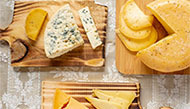Then a few months ago, the London bartender Tony Conigliaro told me that weak cocktails can be more aromatic than stronger drinks. More recently, a barista showed me that I could make tastier coffee by brewing it with less ground coffee and more water. It’s no secret that the alcohol in drinks can get in the way of our enjoying their flavors.
Diluting drinks
can improve
aroma and taste.
Fans and judges of Scotch whiskeys often sample their flavor by “nosing” them, or sniffing the aroma that gathers in the glass. Nosers have long known that diluting the spirit with roughly the same amount of water reduces the alcohol burn. And at the same time, strangely, amplifies the aromas.
How can water reduce one sensation and amplify another? Aroma molecules are more chemically similar to alcohol molecules than they are to water, so they tend to cling to alcohol, and are quicker to evaporate out of a drink when there’s less alcohol to cling to. Audrey Saunders of the Pegu Club in New York told me that realizing this led her to develop a series of what she calls “inverted drinks,” in which spirits play a supporting role to vermouth or other low-alcohol ingredients. Her Madeira Martinez combines one part gin (40 percent alcohol) and two parts Madeira (20 percent) for a drink that starts at around 30 percent alcohol before ice dilutes it further. The goal is to highlight the flavors of the weaker ingredient. High-alcohol wines, those that exceed about 14 percent alcohol, are often described as “hot” and unbalanced. Alcohol’s irritating effects account for the heat.
And chemists have found that high alcohol levels accentuate a wine’s bitterness, reduce its apparent acidity and diminish the release of aroma molecules. Alcohol particularly holds down fruity and floral aromas. Wine dilution has been practiced since the days of ancient Greece, so I tried it on a California zinfandel with 14.9 percent alcohol.
I poured a partial glass of the wine and added about a quarter of its volume in water, to get it down to 12 percent. A glass of the full-strength wine tasted hot, dense, jammy and a little sulfurous, while the diluted version was lighter but still full of flavor, tarter, more fruity than jammy, and less sulfurous. It was no substitute for a true 12 percent wine, made from grapes harvested with less fermentable sugar and a different balance of flavors . But the watered-down wine was surprisingly pleasant, and maybe more suited to summer evenings .
There’s even a place for more water in coffee. I learned this from James Hoffmann, a 2007 winner of the World Barista Championship. Mr. Hoffmann is the proprietor of Square Mile Coffee, a roasting company in London . He offered me a taste of several coffees , all roasted lightly to avoid losing their distinctive qualities in the intense but more generic flavors of a dark roast. Each cup was less concentrated than I’m used to , yet delicious and distinctive.
Mr. Hoffmann explained that industry standards for brewed coffee strength vary greatly, from around 1.25 percent extracted coffee solids in the United States to something approaching 2 percent in Brazil and in specialty coffeehouses. He aims for 1.5 percent, and gets it consistently with the help of a precision water boiler and a digital scale on which he does the brewing, pouring water to the gram. A tablespoon of water more or less can shift the extracted solids by a perceptible amount.
It also matters how the coffee solids are extracted. Mr. Hoffmann said that concentrated brews are often made palatable by using a lot of coffee and reducing the brewing time or the temperature to extract only the easy-going portion of its flavor materials.
The result is intense but one-dimensional. More fully extracting a smaller amount of gently roasted, highquality coffee, as a number of newwave brewing advocates are doing, brings out its full range of tastes and aromas. “When I drink coffee I’m looking for clarity, by which I mean distinguishable, characterful, interesting flavors,” Mr. Hoffmann said. The lightness of his brews did seem to highlight their different aromas, which changed but remained enjoyable even as the remains cooled .
“No other liquid I know evolves as much as you drink it,” he said. So I’m making my coffee with more water now, and getting many more cups from a bag of beans.
HAROLD MCGEE/ESSAY
스마터리빙
more [ 건강]
[ 건강]이제 혈관 건강도 챙기자!
[현대해운]우리 눈에 보이지 않기 때문에 혈관 건강을 챙기는 것은 결코 쉽지 않은데요. 여러분은 혈관 건강을 유지하기 위해 어떤 노력을 하시나요?
 [ 건강]
[ 건강]내 몸이 건강해지는 과일궁합
 [ 라이프]
[ 라이프]벌레야 물럿거라! 천연 해충제 만들기
 [ 건강]
[ 건강]혈압 낮추는데 좋은 식품
[현대해운]혈관 건강은 주로 노화가 진행되면서 지켜야 할 문제라고 인식되어 왔습니다. 최근 생활 패턴과 식생활의 변화로 혈관의 노화 진행이 빨라지고
사람·사람들
more많이 본 기사
- 재외동포, 2년 새 7만5천명 줄었다…181개국에 700만 명 거주
- 유승민, ‘李정부 총리 제의설’ 확인… “생각 다른 사람과 일못해”
- 中왕이 “日일부세력, 역사 후퇴 시도…韓, 올바른 입장 취해야”
- 새해엔 평화 찾아올까…지구촌 희망 찬 신년 맞이
- ‘함께 가는 저녁길’· ‘톰과제리’ 성우 송도순 별세
- 미국 정부, TSMC에도 美반도체장비 中공장 반입 허가
- “라면, 못 끊겠다면 ‘이거’라도 넣어라”
- 성희준의 베이지역 풋볼 (2025시즌 제 17주)
- ‘붉은 말의 해’ 동해안 해맞이객 북적… “건강·평안” 소망 기원
- “학생 백신 접종률 급감”
- “트럼프 리조트의 마사지사들, 엡스타인에 방문 서비스 제공”
- 새크라멘토 CBMC 송년모임 열어
- 알고보니 ‘완전식품’인 고구마의 놀라운 효능
- SF 상공회의소 차기회장에 그린장 SF한인회 부회장
- 트럼프 “시카고·LA 등서 軍철수…범죄늘면 더 강하게 재배치”
- 美국무부 “韓정통망법에 중대 우려…美플랫폼기업에 부정적”
- 낸시랭, 사채 빚 15억 떠안았다..오열 고백 “좀비떼처럼 뜯어 먹어”
- 폭설 속 산행 비극… 마운트 볼디서 3명 조난 사망
- ‘첫 무슬림 뉴욕시장’ 맘다니, 취임… 1
- 원·달러 환율… 연평균 기준 ‘역대최고’ 마감
- 김신호씨, KARL 신임 회장 취임
- 권혁인 목사 /UMC 한인총회장 /산타클라라 연합감리교회
- 오픈AI 직원, 올해 평균 150만 달러치 주식 받아…역대 빅테크 최고
- [새해 달라지는 교통법규] 과속·음주운전 처벌 가주서 대폭 강화
- <종교인 칼럼> ‘자신의 정체성’
- 이진수 목사/북가주남침례교협 회장/헤이워드 침례교회
- ‘상간녀 의혹’ 숙행, 리액션만 간신히 건졌다..무대는 통편집
- “추신수는 지울 수 없는 발자취 남겼다” 美 야구기자, 명예의 전당 투표서 ‘CHOO 선택’ 이유 밝혔다
- 말리·부르키나파소 “미국인 오지마”…美입국 금지에 맞불
- 트럼프, 집권2기 첫 법안 거부권… ‘보복성’ 권한 행사 논란
- “메타, 사기광고 규제 피하려 검색결과 조작…대응지침도 마련”
- “치매에 치즈가 좋대서 맨날 먹었는데”… 고지방 주의
- ‘붉은 말의 해’ 열리다
- 조계종 총무원장 신년 메시지
- 천주교 정순택 대주교 신년 메시지
- 백악관 “미네소타 이어 他민주당 州들… 1
- 신년 연휴 폭풍우… 비 3인치 온다
- 가주 판매 간 소고기 ‘이콜라이’ 오염
- 뉴욕증시 주요지수 3년 연속 상승…S&P500 연간 16%↑
- “10년간 모든 이민 전면 금지?” 황당 주장
- 제야의 종으로 ‘붉은 말의 해’ 시작… “행복 오는 2026년 되길”
- LA 북쪽 테혼 카지노서 하룻새 10만불 ‘연속 잭팟’
- 조세호 ‘조폭 연루설’ 털고 빠른 복귀 수순.. ‘도라이버’ 시즌4 합류
- 4명 군 입대했지만..세븐틴, 13人 완전체 회식 현장 포착
- ‘최하 평점+부상 교체’ 황희찬 대위기, 울버햄튼 무려 ‘19경기 무승+압도적 꼴찌’... 강등권 탈출 ‘빨간불’
- “美서 학생 백신 접종률 급감”… ‘백신의 정치화’ 여파
- 지방세 공제한도 1만→4만달러로 상향 1
- ‘억’ 소리 나는 ‘개념 부부’..신민아♥김우빈·손예진♥현빈
- 22개주서 생굴 먹고 살모넬라균 감염
- [경제 트렌드] AI 열풍 속에 신흥 2030 억만장자 급증
1/5지식톡

-
 미 육군 사관학교 West Poin…
0
미 육군 사관학교 West Poin…
0https://youtu.be/SxD8cEhNV6Q연락처:wpkapca@gmail.comJohn Choi: 714-716-6414West Point 합격증을 받으셨나요?미 육군사관학교 West Point 학부모 모…
-
 ☝️해외에서도 가능한 한국어 선생님…
0
☝️해외에서도 가능한 한국어 선생님…
0이 영상 하나면 충분합니다!♥️상담신청문의♥️☝️ 문의 폭주로 '선착순 상담'만 진행합니다.☎️ : 02-6213-9094✨카카오톡ID : @GOODEDU77 (@골뱅이 꼭 붙여주셔야합니다…
-
 테슬라 자동차 시트커버 장착
0
테슬라 자동차 시트커버 장착
0테슬라 시트커버, 사놓고 아직 못 씌우셨죠?장착이 생각보다 쉽지 않습니다.20년 경력 전문가에게 맡기세요 — 깔끔하고 딱 맞게 장착해드립니다!장착비용:앞좌석: $40뒷좌석: $60앞·뒷좌석 …
-
 식당용 부탄가스
0
식당용 부탄가스
0식당용 부탄가스 홀세일 합니다 로스앤젤레스 다운타운 픽업 가능 안녕 하세요?강아지 & 고양이 모든 애완동물 / 반려동물 식품 & 모든 애완동물/반려동물 관련 제품들 전문적으로 홀세일/취급하는 회사 입니다 100% …
-
 ACSL 국제 컴퓨터 과학 대회, …
0
ACSL 국제 컴퓨터 과학 대회, …
0웹사이트 : www.eduspot.co.kr 카카오톡 상담하기 : https://pf.kakao.com/_BEQWxb블로그 : https://blog.naver.com/eduspotmain안녕하세요, 에듀스팟입니다…
케이타운 1번가
오피니언
 정숙희 논설위원
정숙희 논설위원샴페인, 마지막 날과 첫날을 위하여
 조지 F·윌 워싱턴포스트 칼럼니스트
조지 F·윌 워싱턴포스트 칼럼니스트 [조지 F. 윌 칼럼] 저무는 2025년에 안도의 한숨
 김동찬 시민참여센터 대표
김동찬 시민참여센터 대표 [미국은 지금] 책임 있는 자본 없으면 커뮤니티 미래도 없다
 성영라 수필가 미주문협 부이사장
성영라 수필가 미주문협 부이사장 [수요 에세이] 다시, 제자리로 돌아와서
 신경립 / 서울경제 논설위원
신경립 / 서울경제 논설위원 [만화경] 경영자의 ‘문제적’ 사과
 문태기 OC지국장
문태기 OC지국장 한인 정치력 업그레이드 기대
 민경훈 논설위원
민경훈 논설위원세계 역사를 바꾼 동물
 박홍용 경제부 차장
박홍용 경제부 차장 한인사회가 주목해야 할 새해 경제
 박영실 시인·수필가
박영실 시인·수필가 [화요칼럼] 피드백
1/3지사별 뉴스

지방세 공제한도 1만→4만달러로 상향
2026년 새해에도 뉴욕과 뉴저지 한인들의 일상에 크고 작은 영향을 미치는 다양한 규정과 법규가 새롭게 바뀌게 된다. 당장 1일부터 뉴욕시 최…
■ 사고- 한동대·뉴욕한인청소년센터 국제여름캠프

2025 워싱턴지역 10대 뉴스
다사다난했던 2025년이 하루만 남겨둔 채 역사의 저편으로 저물고 있다. 올해의 가장 큰 뉴스는 트럼프 2기 행정부 출범과 함께 몰아친 이민 …
내년 1월부터 달라지는 MD 법안들

‘붉은 말의 해’ 열리다
‘붉은 말의 해’를 알리기 위해 서울에서는 제야의 종이 울리고 부산에서는 화려한 드론쇼가 펼쳐지는등 세계 각국에서 새해를 맞이했다. 2026년…
권혁인 목사 /UMC 한인총회장 /산타클라라 연합감리교회

오늘 하루 이 창 열지 않음 닫기 




















































.png)


댓글 안에 당신의 성숙함도 담아 주세요.
'오늘의 한마디'는 기사에 대하여 자신의 생각을 말하고 남의 생각을 들으며 서로 다양한 의견을 나누는 공간입니다. 그러나 간혹 불건전한 내용을 올리시는 분들이 계셔서 건전한 인터넷문화 정착을 위해 아래와 같은 운영원칙을 적용합니다.
자체 모니터링을 통해 아래에 해당하는 내용이 포함된 댓글이 발견되면 예고없이 삭제 조치를 하겠습니다.
불건전한 댓글을 올리거나, 이름에 비속어 및 상대방의 불쾌감을 주는 단어를 사용, 유명인 또는 특정 일반인을 사칭하는 경우 이용에 대한 차단 제재를 받을 수 있습니다. 차단될 경우, 일주일간 댓글을 달수 없게 됩니다.
명예훼손, 개인정보 유출, 욕설 등 법률에 위반되는 댓글은 관계 법령에 의거 민형사상 처벌을 받을 수 있으니 이용에 주의를 부탁드립니다.
Close
x